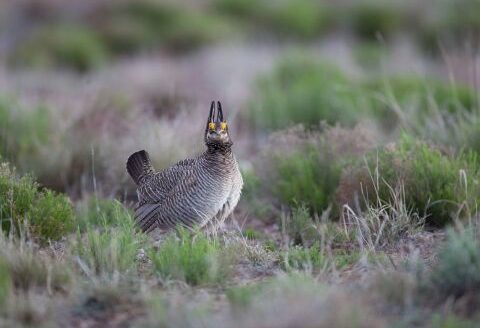Aerial surveys confirm upward trend in lesser prairie-chicken population
The latest lesser prairie-chicken survey shows bird populations are up from last year, continuing an upward trend over the last few years. The survey indicates an estimated breeding population of 38,637 birds this year, compared to 29,934 birds counted last year.
“This approximately 30 percent annual increase is good news, but we know that year-to-year fluctuations are the norm with upland birds like the lesser prairie-chicken,” said Roger Wolfe, WAFWA’s Lesser Prairie-chicken program manager. “The most encouraging result from the survey is the steadily increasing population trend over the last six years, which likely reflects improving habitat conditions.”
Lesser prairie-chickens can be found in four ecoregions in five states: Colorado, Kansas, New Mexico, Oklahoma and Texas. Wildlife biologists note prairie chicken numbers regularly fluctuate up and down from year to year due to changes in habitat conditions mainly influenced by weather patterns. More favorable weather patterns this past year contributed to apparent increases in three of four ecoregions where the birds are found. There is concern that moderate to severe drought over portions of the lesser prairie-chicken range this year may lead to a down turn in the population next year.
The shinnery oak ecoregion of eastern New Mexico and the Texas Panhandle saw the biggest annual increase in birds, followed by the sand sagebrush ecoregion of southeast Colorado and southwest Kansas. The shortgrass ecoregion which covers northwest Kansas also registered an annual increase in the number of breeding birds. The estimated number of birds in the mixed-grass ecoregion spanning the northeast Panhandle of Texas, northwest Oklahoma and south-central Kansas is similar to last year’s estimate.
The annual population surveys are conducted as part of the Lesser Prairie-Chicken Range-wide Plan, a collaborative effort of WAFWA and state wildlife agencies of Texas, New Mexico, Oklahoma, Kansas and Colorado. It was developed to ensure long-term viability of the lesser prairie-chicken through voluntary cooperation by landowners and industry. The plan allows industry to continue operations while reducing and mitigating impacts to the bird and its grassland habitat. Industry contributions support conservation actions implemented by participating private landowners. To date, industry partners have committed more than $64 million in enrollment and mitigation fees to pay for conservation actions, and landowners across the range have agreed to conserve more than 150,000 acres of habitat through 10-year and permanent conservation agreements.
“We’re encouraged by this year’s numbers but are mindful that successful conservation of the lesser prairie-chicken will require decades of consistent progress,” said J.D. Strong, director of the Oklahoma Department of Wildlife Conservation and Chairman of the Lesser Prairie-Chicken Initiative Council. “The continued success of the range-wide plan depends on ongoing participation by industry partners, and we are grateful for the support shown thus far. The U.S. Fish and Wildlife Service will be making another ruling on the status of the lesser prairie-chicken later this year, and industry support of the plan is more important than ever. At such a critical juncture in the conservation of this important but imperiled prairie grouse, we encourage industry to contact us and get involved."
For more information about the Lesser Prairie-Chicken Range-wide Conservation Plan, contact Roger Wolfe at [email protected].


